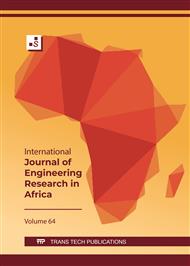[1]
F. Baader, D. Calvanese, D. McGuinness, P. Patel-Schneider, D. Nardi, The Description Logic Handbook: Theory, Implementation and Applications, in: Cambridge University press, 2003.
DOI: 10.1017/cbo9780511711787
Google Scholar
[2]
R. Calegari, G. Ciatto, V. Mascardi, A. Omicini, Logic-based technologies for multi-agent systems: A systematic literature review, Autonomous Agents and Multi-Agent Systems, (2021), 35(1), 1-67.
DOI: 10.1007/s10458-020-09478-3
Google Scholar
[3]
S. Calegari, D. Ciucci, Fuzzy ontology, fuzzy description logics and fuzzy-owl, in: International Workshop on Fuzzy Logic and Applications, Berlin, Heidelberg , Springer, (2007), p.118–126.
DOI: 10.1007/978-3-540-73400-0_15
Google Scholar
[4]
E. M. H. Saeed, Article Review: Survey Fuzzy Logic and Aprior Algorithms Employed for E-learning Environment. Turkish Journal of Computer and Mathematics Education (TURCOMAT), (2021), 12(8), pp.60-69.
Google Scholar
[5]
C. Carlsson, M. Brunelli, J. Mezei. Decision making with a fuzzy ontology, in: Soft. Comput. (16), 2012, p.1143–1152.
DOI: 10.1007/s00500-011-0789-x
Google Scholar
[6]
B. Díaz-Agudo & P.A. González-Calero. An architecture for knowledge intensive CBR systems, in: European workshop on advances in case-based reasoning, Berlin, Heidelberg, 2000, pp.37-48. Springer.
DOI: 10.1007/3-540-44527-7_5
Google Scholar
[7]
A. Martin, S. Emmenegger, K. Hinkelmann & B. Thönssen. A viewpoint-based case-based reasoning approach utilising an enterprise architecture ontology for experience management, in: Enterprise Information Systems. 11(4), 2017, pp.551-575.
DOI: 10.1080/17517575.2016.1161239
Google Scholar
[8]
TP. Lim, W. Husain and N. Zakaria. Recommender System for Personalised Wellness Therapy, International Journal of Advanced Computer Science and Applications. 4 (2013) 54-60.
DOI: 10.14569/ijacsa.2013.040909
Google Scholar
[9]
P.K. Singh & P. Sarkar. Eco-design approaches for developing eco-friendly products: a review, Advances in Industrial and Production Engineering, (2019) 185-192.
DOI: 10.1007/978-981-13-6412-9_17
Google Scholar
[10]
Z. Xu, Z. Lv, J. Li, H. Sun & Z. Sheng. A Novel Perspective on Travel Demand Prediction Considering Natural Environmental and Socioeconomic Factors, in: IEEE Intelligent Transportation Systems Magazine, 2022.
DOI: 10.1109/mits.2022.3162901
Google Scholar
[11]
R. Vinuesa et al. The role of artificial intelligence in achieving the Sustainable Development Goals, in: Nature communications, 11(1), 2020, pp.1-10.
Google Scholar
[12]
Z. Xu, J. Li, Z. Lv, C. Dong & L. Fu. A classification method for urban functional regions based on the transfer rate of empty cars, in: IET Intelligent Transport Systems, 16(2), 2022, pp.133-147.
DOI: 10.1049/itr2.12134
Google Scholar
[13]
E.R. Platcheck, L. Schaeffer, W. Jr. Kindlein and L. Candido. Methodology of ecodesign for the development of more sustainable electro-electronic equipment. J. Clean. Prod. 16, 2008, p.75–86.
DOI: 10.1016/j.jclepro.2006.10.006
Google Scholar
[14]
G. Taddese, S. Durieux & E. Duc. Sustainability performance indicators for additive manufacturing: a literature review based on product life cycle studies, The International Journal of Advanced Manufacturing Technology.107(7) (2020) 3109-3134.
DOI: 10.1007/s00170-020-05249-2
Google Scholar
[15]
IHOBE. Manual práctico de ecodiseño: operativa de implantación en siete pasos,2000.
Google Scholar
[16]
L.M. Agudelo Gutierrez. Aide à décision en conception préliminaire par l'estimation du poids de la performance environnementale (Doctoral dissertation, Paris, ENSAM), 2016.
Google Scholar
[17]
P. Paulraj et al. Environmentally conscious manufacturing and life cycle analysis: a state-of-the-art survey, Journal of Nanomaterials (2022).
Google Scholar
[18]
C. Y. Ng & W. C Tang. Evaluation of design options for green product development: a combined Cuckoo search and life cycle assessment approach, The International Journal of Life Cycle Assessment 27(5) (2022) 665-679.
DOI: 10.1007/s11367-022-02056-7
Google Scholar
[19]
A. Ghoroghi, Y. Rezgui, I. Petri & T. Beach. Advances in application of machine learning to life cycle assessment: a literature review, The International Journal of Life Cycle Assessment (2022) 1-24.
DOI: 10.1007/s11367-022-02030-3
Google Scholar
[20]
M. Germani, M. Dufrene, M. Mandolini, M. Marconi, P. Zwolinski. Integrated software platform for green engineering design and product sustainability, in: Re-engineeringManufacturing for Sustainability (2013, p.87–92. Springer, Singapore.
DOI: 10.1007/978-981-4451-48-2_14
Google Scholar
[21]
M.A. Cusenza, S. Bobba, F. Ardente, M.Cellura & F. Di Persio. Energy and environmental assessment of a traction lithium-ion battery pack for plug-in hybrid electric vehicles, in: Journal of cleaner production, 215, 2019, pp.634-649.
DOI: 10.1016/j.jclepro.2019.01.056
Google Scholar
[22]
D. Böckin & A. M Tillman. Environmental assessment of additive manufacturing in the automotive industry, Journal of Cleaner Production 226 (2019) 977-987.
DOI: 10.1016/j.jclepro.2019.04.086
Google Scholar
[23]
X. Zhang, M. Zhang, H. Zhang, Z. Jiang, C. Liu & W. Cai. A review on energy, environment and economic assessment in remanufacturing based on life cycle assessment method, Journal of Cleaner Production (2020) 255-120160.
DOI: 10.1016/j.jclepro.2020.120160
Google Scholar
[24]
C. Abadi, I. Manssouri & A. Abadi. A Fuzzy Ontology Based Approach to Support Product Eco-Design, in: International Conference on Artificial Intelligence & Industrial Applications, Springer, Cham, 2020, pp.1-13.
DOI: 10.1007/978-3-030-51186-9_1
Google Scholar
[25]
E. Sdrolia & G. Zarotiadis. A comprehensive review for green product term: From definition to evaluation, Journal of Economic Surveys 33(1) (2019) 150-178.
DOI: 10.1111/joes.12268
Google Scholar
[26]
D. Jugend, M. A. P. Pinheiro, J. V. R Luiz, A. V. Junior & P. ACauchick-Miguel. Achieving environmental sustainability with ecodesign practices and tools for new product development. In Innovation strategies in environmental science, Elsevier, 2020, pp.179-207.
DOI: 10.1016/b978-0-12-817382-4.00006-x
Google Scholar
[27]
S. K Takalo & H. S Tooranloo. Green innovation: A systematic literature review, Journal of Cleaner Production 279 (2021) 122474.
DOI: 10.1016/j.jclepro.2020.122474
Google Scholar
[28]
F. Bobillo, U. Straccia. The fuzzy ontology reasoner fuzzyDL, in: Knowl.-Based Syst. (95), 2016, p.12–34.
DOI: 10.1016/j.knosys.2015.11.017
Google Scholar
[29]
C. Abadi, I. Manssouri, , et A. Abadi. An Artificial-Intelligent-Based System to Automate the Design of Complex Mechanical Products, International Journal of Engineering Research in Africa, Trans Tech Publications Ltd. (2022) 247-274.
DOI: 10.4028/www.scientific.net/jera.58.247
Google Scholar
[30]
A. Abadi, H. Ben-Azza, S. Sekkat, E.M. Zemmouri. A Fuzzy Ontology-based approach for multi-criteria decision-making: a use case in supplier selection, in: Congrès International Du Génie Industriel Et Du Management Des Systèmes, Meknes, 2017.
Google Scholar


